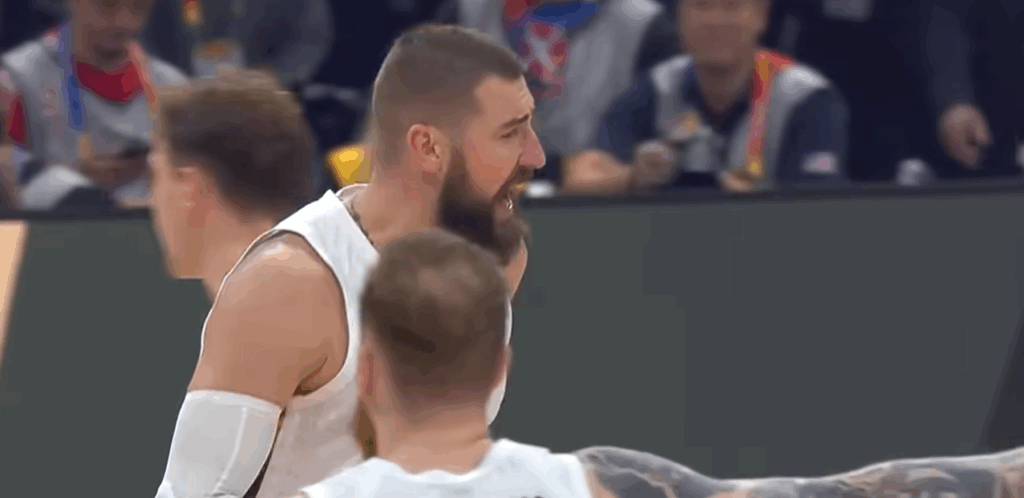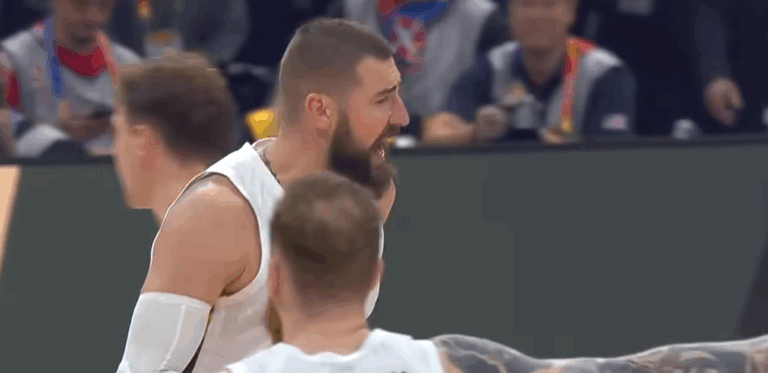By utilizing something that is frequently overlooked—his weight—Jonas Valanciunas is changing the narrative in a time when centers’ primary tools are agility and range. He weighs 265 pounds, making him one of the heaviest NBA players currently in play. He is much bulkier than Dario Šarić, who weighs 102 kg, and heavier than Al Horford and Domantas Sabonis, who weigh 109 kg. There is more to this physical difference than meets the eye. It establishes his legacy and defines his game.
Valanciunas is more than just a basketball player; he makes an impression. His weight has given him the ability to control the paint over the years in a manner that is impossible for smaller, faster players to match. He utilized his bulk to box out opponents, create space beneath the rim, and absorb contact without losing his balance, especially during his best seasons with Memphis and New Orleans. Despite their subtle execution, these moves have shown remarkable effectiveness on both ends of the floor.
He frequently faced off against the league’s most athletic centers while playing for the Grizzlies, regularly averaging double-digit rebounds. Analysts started to value his game for its substance rather than its glitz. He made size into strategy by remaining grounded, both literally and figuratively. His style of play is very similar to that of classic centers like Arvydas Sabonis and even a younger Marc Gasol, who prioritized balance and strength over speed.
| Attribute | Details |
|---|---|
| Full Name | Jonas Valančiūnas |
| Date of Birth | May 6, 1992 |
| Age | 33 |
| Nationality | Lithuanian |
| Height | 6 ft 11 in (2.11 m) |
| Weight | 265 lbs (120 kg) |
| Position | Center |
| Current Team | Denver Nuggets (NBA) |
| Jersey Number | 17 |
| NBA Draft | 2011, 1st round, 5th overall by Toronto Raptors |
| NBA Debut | 2012 |
| Previous Teams | Raptors, Grizzlies, Pelicans, Wizards, Kings |
| Spouse | Eglė Valančiūnienė |
| Children | Jonas Valančiūnas Jr. |
| National Team | Lithuania Men’s Basketball Team |
| Listed Wingspan | 7 ft 3 in (221 cm) |
| Source | Basketball-Reference |

His shooting range significantly increased during his time with the Pelicans. In addition to being a force on the rim, Valanciunas began to step out, making mid-range jumpers and even draining threes. His 265-pound frame became even more dangerous as a result of this development since it forced defenders to move outside, giving offensive schemes greater leeway. He recorded 39 points and 15 rebounds in one particularly memorable game against the Clippers, a stat line that demonstrated his adaptability and tenacity.
His role has changed over time, but his weight has stayed the same. Despite alternating between the Wizards and Kings during the 2024–2025 season, he remained highly productive. He demonstrated that his size wasn’t a hindrance by averaging 11.5 points and more than eight rebounds in a small number of minutes. It might even have been keeping him alive. Heavy players’ durability is frequently questioned, but Valanciunas has shown remarkable durability, missing comparatively few games over a career spanning over ten years.
Valanciunas now plays in Denver alongside a player with a similar build, Nikola Jokić. It’s especially interesting when two big, smart, heavy men are paired together. The Nuggets have a history of leveraging strength and vision to their advantage, despite concerns about pace. In fact, when rotations get tight, Valanciunas’ presence could anchor the defense and free up Jokić for more inventive plays. Taking into account how European big men like these have changed NBA expectations and demonstrated that mobility can come in many forms—not just from lean frames—makes the team dynamic even more intriguing.
Valanciunas’ weight is brought up in more general league discussions about body diversity and performance. There has been tremendous pressure to fit into slimmer, more explosive archetypes as basketball has changed. Valanciunas, however, continues to serve as evidence that skill and strength can work in concert to great effect. Younger athletes who might not fit the traditional mold but have the capacity to creatively impose their physicality will especially benefit from this.
The value of large men who can control the interior has been gradually returning to the industry trend. Brook Lopez, Joel Embiid, and even up-and-coming players like Victor Wembanyama demonstrate the continued significance of size. However, none exude the same sense of traditional authority as Valanciunas. His capacity to lead groups without claiming the limelight is an example of professionalism and flexibility.
The impact of weight management on performance is frequently disregarded by fans. It is anticipated that centers like Valanciunas will strike a balance between being heavy enough to hold their ground and light enough to prevent wear, while guards and wings will likely slim down for speed. Jonas is an expert at striking this balance. He doesn’t appear to be resisting his body. Rather, he performs as if it has been tailored to the precise part he plays.
His defensive skills, particularly his ability to grab rebounds, are still very impressive. By maintaining his position, predicting movements, and enclosing opponents with his body, he frequently outmanoeuvres lighter but more athletic players. His slower lateral movement is criticized by some, but he makes up for it with deft positioning and anticipation, showing that intelligence frequently triumphs over sheer speed.
This practical approach is not limited to the court. Respected by both coaches and teammates, Valanciunas has stayed away from the controversies that frequently encircle well-known athletes. He instead emphasizes development, resiliency, and teamwork—qualities that, along with his physical attributes, have made him subtly powerful. His story serves as a reminder to basketball fans that sometimes the impact is felt in the trenches rather than above the rim.


